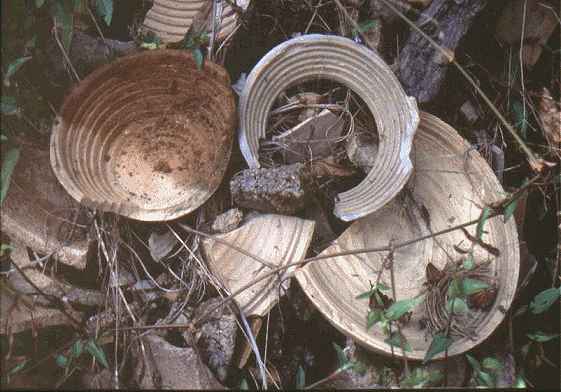
Description of the Twenty
Illustrations of the Manufacture of Porcelain
By Tang Ying, Director of the Imperial Factory at Jingdechen,
in obedience to an Imperial edict... (1743)

Song Dynasty stepped setters as found on the ground in the Hutien village just outside of Jingdezhen in 1992. The steps on the inside is for upside-down (fushao) firing of Qingbai bowls and dishes with unglazed rim. These setters was probably fired together with the bowls inside larger pot shaped saggars.
Photo © Jan-Erik Nilsson, 1992
4. Manufacture of the Cases, or Saggars
"The porcelain while being fired in the furnace must be kept perfectly clean: a single spot of dirt makes a colored stain. Moreover, the blast of air and fierce flames of the furnace would injure the delicate paste.
For these reasons it is necessary to place the porcelain inside saggars. The clay used in making these cases comes from the village of Li-ch'un, which is on the northeast of Jingdezhen. It is of three different colors - black, red and white.
A kind of blackish yellow sand, which is found at Pao-shih-san, is mixed with the clay to form a paste, so that it may be more readily fired.
The cases are fashioned on a wheel, which is similar to the wheel used for porcelain.
The paste need not be finely levigated. After the cases have been partially dried they are roughly finished off with a knife, put into the furnace, and fired for the first time empty. When baked and ready for use, they are called by the name of tu-hsia, or 'finished cases'.
The workmen who manufacture the saggars are used to - with the same coarse paste - to make, on the same wheel, a supply of earthenware bowls for the daily use of the potters in their native hamlets."
This page is based on an original translation from Chinese by S.W. Bushell, 1899, of a text written on Imperial command in 1743 by Tang Ying, the celebrated superintendent of the porcelain manufacture in the province of Jiangxi. It is widely reprinted. The version most likely to be authentic is the version found in the official annals of the province of Jianxi, Book XCIII, folio 19-23. The first draft seems to have been written in 1735. The version above was added to a set of 'twenty illustrations of the manufacture of porcelain' in 1743. The actual illustrations have never been identified. The text as it appears here is illustrated with photos taken on location by Jan-Erik Nilsson in 1991 and 1992.

